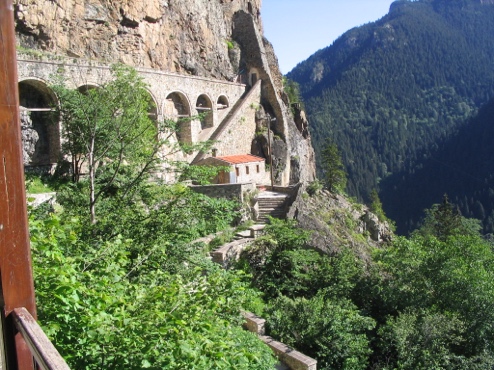A few miles south of Trebizond lay Soumela, the richest and most spectacularly sited of the monasteries of Byzantine Trebizond. The Altindere Valley begins as a narrow gorge only wide enough for a roadway beside the flowing current, but upstream the valley widens out between steep slopes covered with trees of all shades of green amid wispy clouds floating past. During the ascent under the shade of these trees can be heard the sound of the cascading water far below. Then suddenly appears the multi-storeyed monastery perched on the narrow ledge of the sheer cliff about 300 meters above. A small aqueduct winds around the cliff face above the steep flight of steps leading up to the entrance. The monastery contained guesthouses, a library and a remarkable marble basin to catch drops of moisture falling from 100 feet above. The main church itself was formed by walling up a cave in the cliff and painting all the inside and outside surfaces with frescoes arranged in an unusual narrative sequence of panels. The monastery was also famed for its wealth and treasures, including the legendary miraculous icon of the Virgin Mary painted by St. Luke.
After the Orthodox monks were expelled in 1923, the monastery and its frescoes were exposed to vandalism, but relics hidden by the fleeing monks were recovered years later and were rededicated in a new monastery at Mt Vermio in northern Greece. It is not known if Gilbert visited the recently abandoned monastery of Soumela as he does not mention it in his letters and took no photographs.


